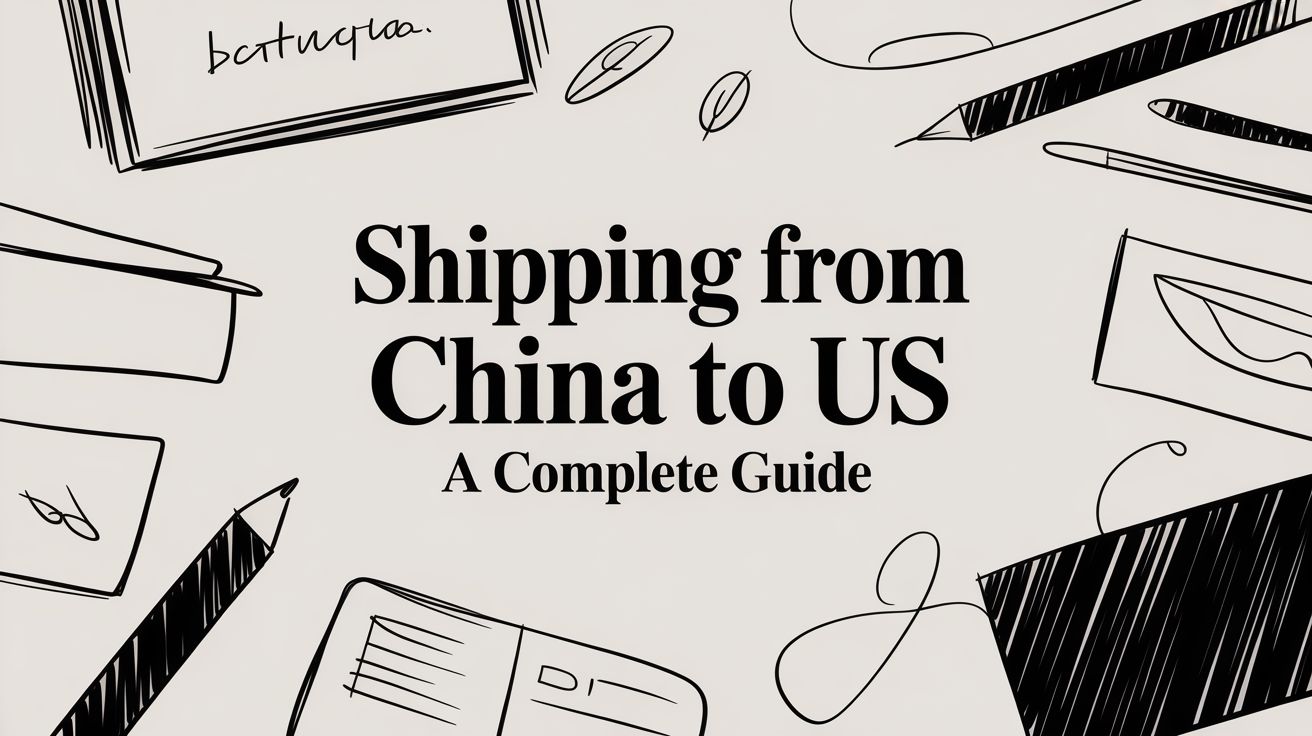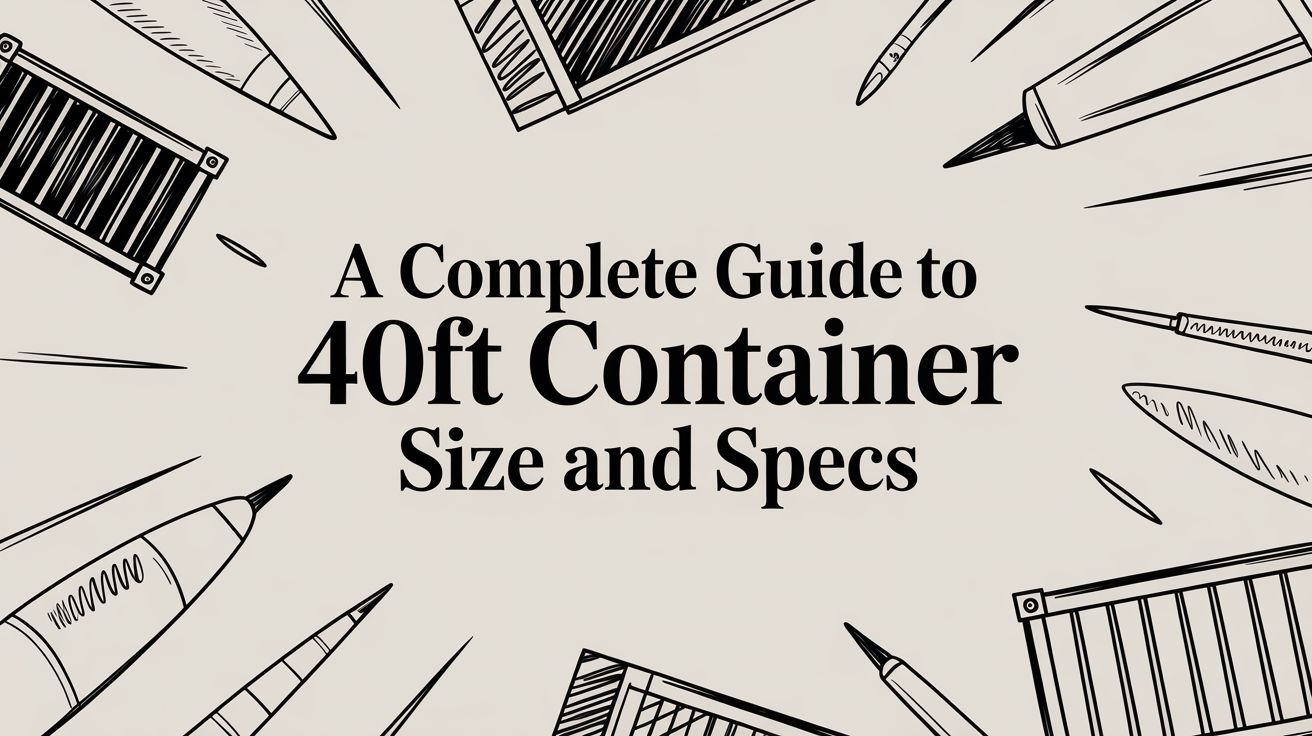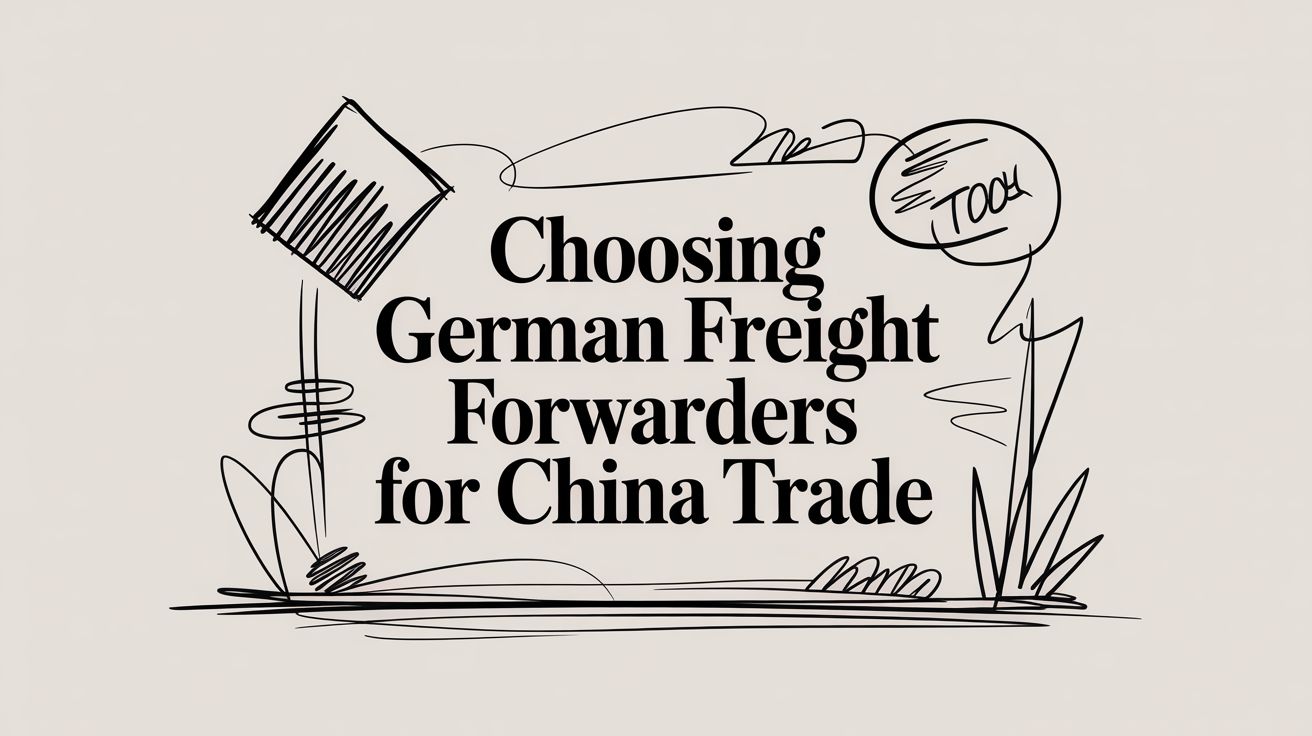When you're figuring out how to get your products from China to the US, the first big decision you'll face is a classic trade-off: speed versus cost. If you need something yesterday or are shipping high-value items, air freight is your go-to, getting your goods stateside in a matter of days. But for bigger shipments where time isn't the most pressing issue, sea freight is your best bet, offering huge cost savings even though the journey takes weeks, not days.
Choosing Your Shipping Method: Air vs. Sea Freight
The entire journey your goods take from a Chinese supplier to a US warehouse boils down to one simple question: will they fly or will they sail? It’s a bit like choosing between a sprinter and a marathon runner. Each serves a very different purpose, and picking the right one comes down to what your business needs most: speed, budget, or volume. This choice is the foundation of your whole shipping strategy.
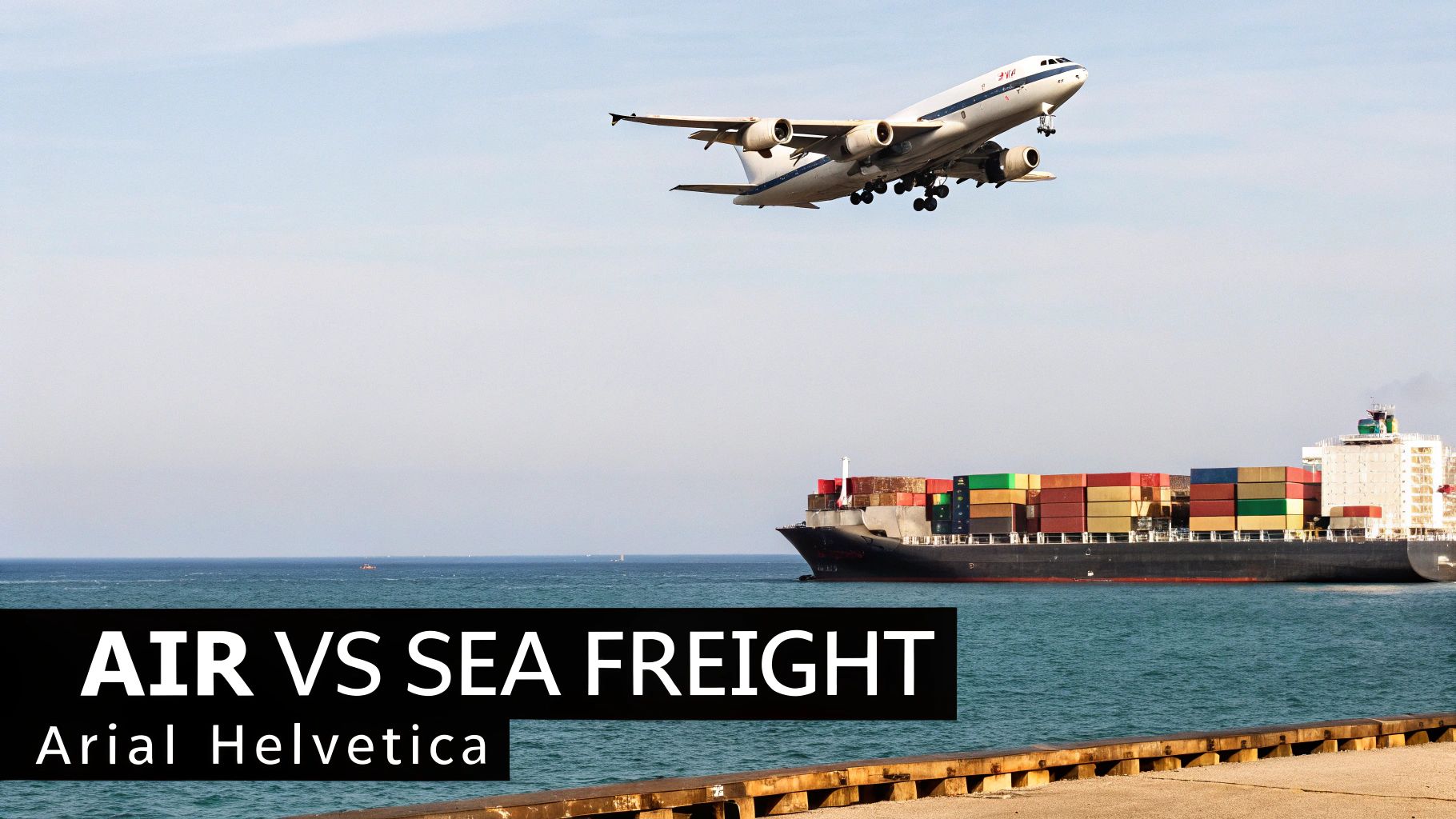
This graphic really highlights the two main routes your cargo can take. The takeaway is crystal clear: air offers a fast, direct path, while the sea provides a longer, but much more economical, journey for larger shipments.
The Case for Speed: Air Freight
Think of air freight as the express lane of international shipping. It's the only real option when time is money. Are you launching a hot new product, scrambling to fill a backorder, or moving delicate, high-value electronics? In these cases, the extra cost of flying your goods is almost always worth it.
A typical air shipment can get from China to the US in just 5-10 days. That’s a world away from the weeks you’d wait for a boat. This kind of speed gives you incredible flexibility, letting you respond to market shifts in real-time and keep less cash tied up in inventory. But that speed comes at a premium. Air freight costs are based on chargeable weight, which makes it significantly more expensive than sea freight, especially for anything heavy or bulky.
The Power of Volume: Sea Freight
Sea freight is the undisputed workhorse of global trade, carrying the overwhelming majority of everything that moves around the planet. It’s hands-down the most cost-effective choice for any business that can plan its inventory out in advance. If you're shipping furniture, car parts, or pallets of consumer goods, the savings are too big to ignore.
The price you pay for this affordability is time. A container ship sailing from China to the US will usually take 30 to 45 days to arrive, and sometimes even longer if there’s port congestion. This long lead time means you have to be on top of your inventory planning to avoid running out of stock.
Sea freight is the perfect fit for:
- Bulk Shipments: When you're moving a large quantity of product all at once.
- Heavy or Oversized Items: For cargo that's simply too big or heavy to fly.
- Non-Urgent Goods: Best for products with steady demand that you can order months ahead.
Picking the right mode is a strategic balancing act. Air freight slashes your transit time and reduces how much you spend on holding inventory. On the other hand, sea freight crushes costs on larger volumes, which directly improves your product’s landed cost and, ultimately, your profit margin.
Making the Right Call for Your Business
So, how do you decide? It all starts with your product and your customers. Are your goods perishable? Are you in a fast-fashion market where trends change in a blink? If so, speed is king. Or are you selling staple items with a predictable sales cycle where keeping costs low is the top priority?
To help you weigh the pros and cons, here's a quick side-by-side comparison.
Air Freight vs. Sea Freight: A Quick Comparison
This table breaks down the essential differences between air and sea freight, giving you a clear snapshot to help you decide what works best for your specific business needs.
| Factor | Air Freight | Sea Freight |
|---|---|---|
| Transit Time | Fast (5-10 days) | Slow (30-45+ days) |
| Cost | High | Low |
| Volume Capacity | Limited (best for smaller shipments) | Vast (ideal for bulk, large items) |
| Reliability | Very High (fewer delays) | Moderate (weather/port delays possible) |
| Best For | Urgent, high-value, or lightweight goods | Bulk, heavy, or non-urgent goods |
Ultimately, there’s no single "best" answer. The right choice depends entirely on your situation.
Look beyond just the freight quote and consider the total cost. Slower sea freight might force you to hold more inventory in a warehouse, tying up capital that could be used elsewhere. Conversely, the high price of air freight can eat into your profit margins if it isn't used for the right reasons. To get a better sense of how these pieces fit together, you can learn more about specific air freight solutions and how they function in a modern supply chain. The best method is the one that lines up perfectly with your company's budget and operational flow.
Decoding Sea Freight: FCL vs. LCL Shipments
Once you've decided sea freight is the right move for your goods from China to the US, you'll hit your next big decision: Full Container Load (FCL) or Less than Container Load (LCL). Getting this choice right is absolutely critical, as it directly shapes your shipping costs and delivery schedule.
So, what's the difference? Let's use a simple analogy.
FCL is like hiring your own private minibus. You book the entire vehicle, and it doesn't matter if you fill every seat. It's all yours, and it drives directly to your destination with no extra stops. With FCL, your cargo gets an entire shipping container to itself.
LCL, on the other hand, is like buying a single ticket on a public bus. You pay just for your seat, sharing the journey with other people heading in the same general direction. Your goods are grouped together with shipments from other businesses to fill up a shared container.
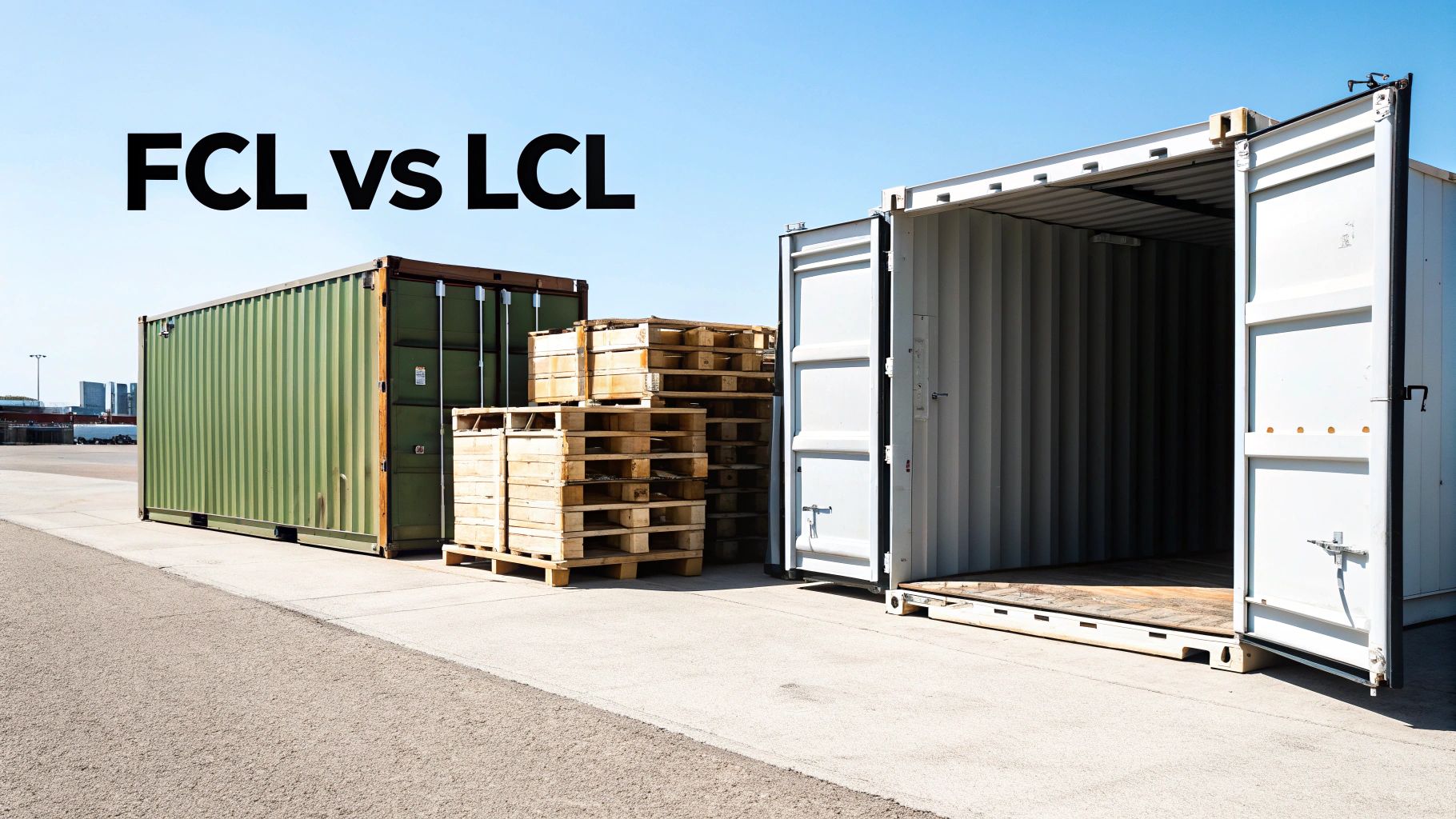
This core difference—exclusive use versus shared space—creates a unique set of pros and cons for each method, especially when you look at cost, security, and how quickly your goods arrive.
When to Choose Full Container Load (FCL)
For businesses moving serious volume, FCL is the industry standard. If you have enough cargo to fill most of a 20-foot or 40-foot container, FCL nearly always works out to be cheaper on a per-unit basis. You're paying a flat fee for the whole box, so the more you stuff in there, the lower your cost per cubic metre gets.
But the advantages of FCL aren't just about saving money on big shipments.
- It’s Faster: FCL shipments get to skip the queue. There's no waiting around at the port to be bundled with other cargo (consolidation) or separated on arrival (de-consolidation). This alone can slice several days, sometimes over a week, off your total transit time compared to LCL.
- It's More Secure: Your container gets sealed at your supplier's factory and isn't opened again until it reaches your warehouse in the US. This drastically lowers the risk of damage, theft, or contamination that can happen when goods are handled multiple times.
As a rule of thumb, if your shipment is around 15 cubic metres (CBM) or more, it's time to start running the numbers on FCL. Even if you can't quite fill it to the brim, the extra speed and security might be well worth the cost.
The Flexibility of Less than Container Load (LCL)
For smaller businesses, e-commerce sellers, and anyone just starting out or testing a new product, LCL is a lifesaver. It gives you the power to ship smaller quantities from China without having to foot the bill for an entire container you simply don't need. You're charged based on the volume or weight of your cargo—whichever is greater.
This "pay-as-you-go" approach offers fantastic flexibility. The trade-off, however, is time. LCL shipments need extra processing at both ports for all that sorting and bundling, which adds to the overall journey time. And because your products are sharing space, they'll be handled more often, which slightly increases the risk of damage if they aren't packed securely.
If you want to dive deeper into the specifics, our detailed guide on less-than-container-load shipping is a great resource.
The Key Takeaway: The choice between FCL and LCL really comes down to a straightforward balance of volume, cost, and urgency. FCL is your best bet for speed and security on larger shipments. LCL offers unmatched cost-effective flexibility for smaller ones.
Understanding Global Trade Routes and Realities
When you book a shipment from China to the US, it’s easy to imagine your container sailing in a straight line across the Pacific. The reality, however, is a lot more complicated. Your cargo's journey is shaped by a tangled web of geopolitics, critical maritime pathways, and the sheer unpredictability of Mother Nature—all of which can directly hit your delivery times and bottom line.
Think of the major shipping lanes less like open highways and more like bustling city streets with notorious bottlenecks. A single slowdown in one of these "chokepoints" creates a traffic jam that sends ripples across the entire supply chain. Getting a handle on these external forces isn't just an academic exercise; it's fundamental to managing risk and building a business that can weather a few storms.
Navigating Maritime Chokepoints
One of the world’s most vital arteries for trade is the South China Sea. A huge slice of the goods leaving Chinese ports has to travel through this region to get to the West. You can't overstate its strategic importance, which is why it’s often a hotbed of international interest and, at times, tension.
Any disruption here—whether from a political squabble or a surge in naval patrols—can force shipping lines to take longer, more expensive detours. That adds days to the journey and burns more fuel, costs that are always passed down to you.
The sheer volume of commerce flowing through this area is staggering. It’s a powerful reminder that your shipment is part of a much larger global ecosystem, where regional stability is directly linked to supply chain efficiency.
The financial stakes are massive. Back in 2016, an estimated $3.4 trillion in trade passed through the South China Sea. Of that, a staggering $1.2 trillion was trade flowing between China and the US alone. This just goes to show how sensitive the shipping from China to US corridor is to any hint of instability in the area.
The Impact of Trade Policies and Tariffs
Beyond the physical routes, the political climate is a huge player. Trade policies and tariffs between the US and China seem to be in a constant state of flux, and these high-level government decisions have immediate, real-world impacts on importers. A sudden tariff hike can completely change the final landed cost of your products, potentially wiping out your profit margin overnight.
For instance, the announcement of new tariffs can trigger a mad dash as businesses scramble to ship their goods before the higher rates kick in. This sudden surge in demand leads to a cascade of problems:
- Port Congestion: Terminals get swamped with containers, creating long lines of ships waiting to load or unload.
- Capacity Shortages: Space on vessels evaporates, making it tough and expensive to even get a booking.
- Rate Spikes: When demand skyrockets past supply, carriers don't hesitate to roll out General Rate Increases (GRIs) and peak season surcharges.
Keeping a close eye on the current trade landscape is non-negotiable. For many businesses, building direct relationships with suppliers is a smart way to get a better grip on costs and production schedules. For example, learning the ins and outs of sourcing jewelry from Chinese manufacturers shows how these partnerships can give you more control in a volatile market.
Unpredictable Delays from Weather and Nature
Finally, you can never discount the power of nature. The Pacific typhoon season, which typically runs from May to October, can easily force ships to reroute or sit in port to ride out a storm. Just one major weather event can throw shipping schedules into chaos for weeks.
These are the kinds of delays that are completely out of anyone's hands. It’s a stark reminder of why you absolutely must build buffer time into your shipping plans. Banking on a best-case-scenario transit time is one of the most common—and costly—mistakes you can make. A truly resilient supply chain is one that plans for the unexpected, so a storm on the other side of the world doesn’t leave you with empty shelves.
Navigating Customs and Required Documentation
For many businesses, just hearing the words "customs clearance" can be daunting. It brings to mind a confusing maze of forms, codes, and regulations where one tiny mistake could mean massive delays and surprise fees. But it doesn't have to be that way. Once you get a handle on the key documents and the overall process, you can turn this potential headache into a smooth, predictable step in your supply chain.
Think of it like getting a passport for your products. Just as a person needs the right visa and ID to cross a border, your goods need a complete and accurate set of documents to legally enter the United States. Without them, your shipment is going nowhere fast.
This infographic lays out the physical journey, but the real secret to a smooth trip lies in the paperwork that travels alongside it.
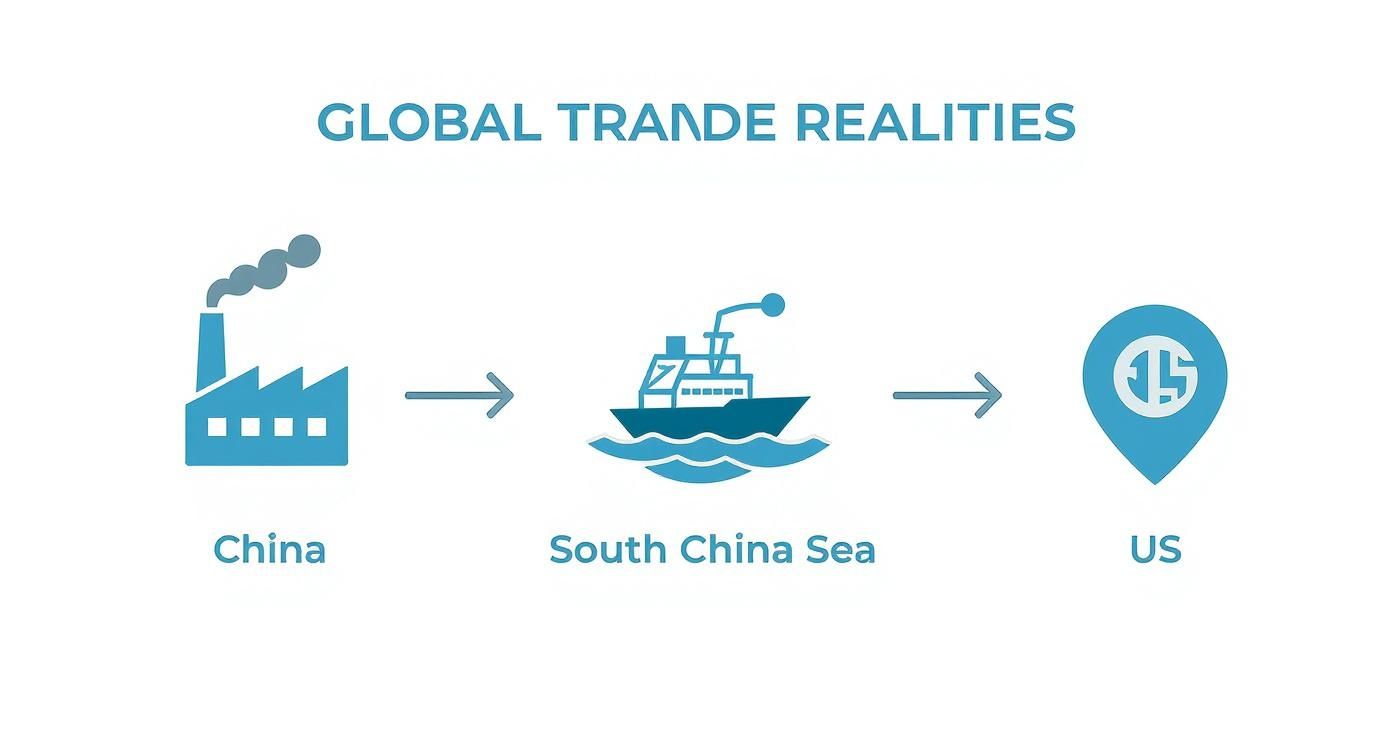
While this shows the direct path your goods take, it's that invisible layer of perfect documentation that truly paves the way for a seamless arrival.
The Essential Paperwork Trio
International trade can involve dozens of forms, but for almost every shipment, it all boils down to three core documents. Getting these right is absolutely non-negotiable.
Commercial Invoice: This is the most important document for customs. It’s the official bill of sale that details the buyer, the seller, what the goods are, the quantity, and the value of everything. U.S. Customs and Border Protection (CBP) uses this to figure out the duties and taxes you owe.
Packing List: This document gives a detailed look at how your shipment is packed. It lists the net and gross weight, the dimensions of each box, and any identifying marks. It allows customs officials to verify the cargo without having to physically unpack the entire container.
Bill of Lading (B/L) or Air Waybill (AWB): This is your contract with the carrier. It serves as both a receipt for the shipment and the title to the goods. You'll get a Bill of Lading for sea freight and an Air Waybill for air freight.
Consistency across these three documents is everything. If the value on your invoice doesn't line up with the items on your packing list, it will instantly raise red flags with customs and grind your shipment to a halt.
Understanding Duties, Taxes, and HS Codes
Once your paperwork is sorted, the next step is figuring out what you owe. This is where Harmonized System (HS) codes enter the picture. Every product imaginable has a specific HS code—a universal language that tells customs officials exactly what you’re importing.
This code is crucial because it dictates the duty rate applied to your goods. Using the wrong one can mean overpaying duties or, even worse, underpaying and getting hit with penalties down the road. For example, different types of consumer electronics carry vastly different duty rates, so a simple misclassification can be a very expensive mistake.
Duties and taxes are the fees charged by the U.S. government on imported goods. The final amount is calculated based on the product's declared value (from your Commercial Invoice) and its specific HS code.
The Role of a Customs Broker
Trying to navigate this complex world on your own is a huge challenge, especially if you're running a small or medium-sized business. This is precisely why the vast majority of importers rely on a licensed customs broker.
A customs broker is a professional who acts as your agent, making sure your shipment ticks all the right boxes for import. They handle submitting all the paperwork to CBP, classifying your goods with the correct HS codes, and arranging the payment of duties and taxes. Their expertise is invaluable for sidestepping clearance problems and keeping your cargo on the move.
If you'd like a deeper dive, our guide on professional customs clearance explains it all. Ultimately, hiring a good broker isn't just about convenience—it's a smart, strategic move to minimise risk and protect your bottom line.
How to Figure Out (and Lower) Your Shipping Costs
Trying to pin down the real cost of shipping from China to the US can feel like guesswork. The quote you get from a freight forwarder isn't just one number; it's a puzzle of different charges, fees, and surcharges that pile up quickly. To get a real handle on your budget, you need to first see what’s actually inside that quote and then use some smart tactics to trim the fat.
Think of your total shipping expense as the "landed cost". This is the all-in price to get your product from the factory in China all the way to your warehouse door in the US. It’s not just the freight—it’s the customs duties, insurance, and all the little handling fees in between. Mastering this final number is one of the single biggest moves you can make to boost your profit margins.
What's Inside a Standard Freight Quote?
When a freight forwarder sends you a quote, it should be broken down into individual line items. The terminology can differ slightly between companies, but you’ll almost always find these key pieces:
- Base Freight Charge: This is the main fee for moving your goods from the starting port to the destination port. It's the core cost of the sea or air journey.
- Fuel Surcharges (BAF/FAF): The Bunker Adjustment Factor (for sea) or Fuel Adjustment Factor (for air) accounts for the ever-changing price of fuel. It’s a variable charge that can swing up or down.
- Terminal Handling Charges (THC): Ports on both ends charge these fees for the physical work of loading, unloading, and moving your container or cargo around their facility.
- Customs Clearance Fees: This is what you pay your customs broker for their service—they prepare and file all the necessary paperwork with CBP so your goods can legally enter the country.
Once you can read these line items, you can start spotting where your money is really going and where you might be able to save.
Smart Ways to Lower Your Shipping Bill
After you've decoded the quote, you can start making moves to cut your total spend. This isn't just about chasing the lowest price from a carrier; it's about making your whole shipping operation smarter and more efficient.
One of the most powerful strategies is shipment consolidation. Let's say you have several small LCL shipments coming from different suppliers. A sharp freight forwarder can group them all into a single FCL container. This simple move can slash your per-item shipping cost because you’re tapping into the much better economics of a full container load.
Timing is another huge factor. Shipping has its seasons. In the months running up to big holidays like Christmas, demand goes through the roof, and so do freight rates. If you have the flexibility, shipping during the off-season (like March to April) can save you a bundle.
Don’t forget about your packaging. It directly affects your costs. By making your packaging as light and compact as possible—without risking damage, of course—you can squeeze more products into a container or lower the chargeable weight for air freight. Every centimetre you save adds up.
How Your Choice of Incoterms Affects the Final Price
The Incoterms you agree to with your supplier have a huge say in your final costs. These are the universal rules of the road for international trade, spelling out exactly who is responsible for the goods (and the bills) at every step of the journey.
Let's look at the two you’ll see most often:
- EXW (Ex Works): With this term, you (the buyer) are on the hook for everything the second the goods leave the factory. That means you’re arranging and paying for local transport in China, export customs, the main freight journey, and everything that follows. It gives you total control, but it also gives you total responsibility and cost.
- FOB (Free On Board): Here, the seller takes care of getting the goods to the port in China and loaded onto the ship. Your responsibility (and your costs) begin only after the cargo is safely "on board" the vessel. For many importers, this strikes a much better balance, taking the complicated origin logistics off your plate.
Often, choosing FOB over EXW can save you both money and a lot of headaches, since your supplier is handling the tricky process of navigating the origin port and customs. For any business that depends on shipping, understanding broader e-commerce best practices helps you make smarter choices across your entire supply chain. At the end of the day, a solid logistics plan is fundamental to a thriving online business.
Frequently Asked Questions About Shipping from China
Even with the best-laid plans, shipping from China to the US can throw a few curveballs your way. It’s a complex process, and questions are a natural part of it. Let's tackle some of the most common ones we hear from businesses, giving you the clear, straightforward answers you need to feel confident.
How Long Does Shipping from China to the US Take?
This is usually the first question on everyone's mind, and the honest answer is: it depends. Your timeline is a direct trade-off between speed and cost. While there's no magic number, here are the general timeframes you can build your plan around.
- Standard Air Freight: If you need it fast, this is your go-to. You're typically looking at 5-10 days from your supplier's door to yours in the US.
- Expedited Sea Freight: A great middle ground. These premium ocean services can shave off significant time, landing your shipment in about 20-25 days. It’s faster than standard sea freight without the full cost of air.
- Standard Sea Freight: This is your most budget-friendly option, but it requires patience. Plan for 30 to 45 days just for the port-to-port journey, plus a bit more for ground transport on both ends.
Remember, these are just averages. Things like port congestion, a customs hold-up, or even a bad storm can easily add delays. Always, always build some buffer time into your schedule.
Do I Really Need to Hire a Freight Forwarder?
For nearly every business out there, the answer is a firm "yes." Could you technically manage an international shipment yourself? Sure. Should you? Absolutely not. It’s an incredibly tangled web of paperwork, regulations, and coordination.
Think of a freight forwarder as your logistics quarterback. They don’t own the ships or planes, but they have deep relationships with all the carriers. This network is what allows them to find the best routes and rates that you could never access on your own.
A good freight forwarder isn’t just a booking agent; they're a strategic partner. They orchestrate the entire move—from wrestling with the mountain of documentation to coordinating with customs and arranging the final truck to your warehouse. They solve problems before you even know they exist.
Frankly, their expertise is your greatest advantage. They live and breathe the nuances of customs rules and carrier networks, saving you from a world of headaches and costly mistakes.
What Are Tariffs and How Do They Affect My Costs?
Put simply, tariffs are a type of tax the U.S. government places on specific goods imported from other countries, very much including China. They’ve been a huge factor in recent years, with rates on many Chinese products changing based on trade policy.
It's critical to know that tariffs are completely separate from your shipping costs and standard customs duties. They are an extra fee, calculated using your product’s specific HS code. Because these rates can change, sometimes with little notice, you have to stay on top of them. The Section 301 tariffs, for example, have hit a huge range of products coming from China.
Is Shipping Insurance Necessary and What Does It Cover?
Yes. Full stop. Consider it non-negotiable. While carriers have a legal requirement for some liability coverage, it’s shockingly minimal. It often won't even come close to covering the actual value of your goods if they get lost, damaged, or stolen.
This is where cargo insurance steps in. For a relatively small fee, you get financial protection for the full value of your products against pretty much anything that can happen during transit.
- All-Risk Coverage: This is what you want. It's the most comprehensive policy, covering your goods against almost any physical loss or damage from an external cause.
- Named Perils Coverage: This is more limited. It only covers losses from specific events listed in the policy, like a fire or the ship sinking.
Given that your products are crossing an ocean, skipping insurance is a massive gamble. It's a small price for the peace of mind and financial safety it provides. Getting a handle on these key issues will put you in a much stronger position to manage your shipments with clarity and control.
